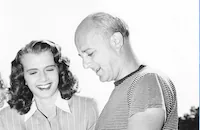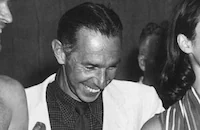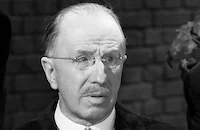Night Waitress

Brief Synopsis
Cast & Crew
Lew Landers
Margot Grahame
Gordon Jones
Vinton Haworth
Marc Laurence
Billy Gilbert
Film Details
Technical Specs

Synopsis
While working as a night waitress on the San Francisco dockside, Helen Roberts meets Martin Rhodes, a schooner captain. Martin is waiting for Mario Rigo, a friend's brother, to discuss a mysterious cargo shipment. Because she is on probation for a crime she committed unwittingly, Helen is at first wary of Martin, but finally gives in to his charms and agrees to spend an afternoon with him, unaware that he is being followed by gangsters George Skinner and Dorn. When Martin glibly confesses his past as a rum- and gun-runner, Helen expresses her disapproval and, as they watch the construction workers on the Golden Gate Bridge, tells him she would like him more if he had a decent, honest job. The next night, Rigo shows up at Helen's restaurant and is surrounded by Skinner, Dorn and two other gangsters, who have been sent by Borghum, a phony private investigator, to track down the shipment. Before being shot to death, Rigo scribbles a map on a napkin and slips the napkin to Helen with instructions to pass it on to Martin. After the shooting, Helen is taken to police headquarters for questioning but, in spite of the police's tough interrogation, remains silent about Martin. When she returns home, however, she is attacked by Skinner, who struggles with her for the napkin and eventually falls out of her window to his death. Followed by Dorn, Helen finds Martin at his schooner and, after assuring herself of his innocence, reconstructs Rigo's cryptic map from memory. Together Helen and Martin interpret Rigo's map and determine that he planted a shipment of stolen gold under the schooner. Dorn, meanwhile, notifies Borghum about Martin's whereabouts, and just after Martin leaves to present his discovery to the district attorney, the gangsters take over the boat. Eventually Martin traces the schooner by following a trail of oil left by his shipmate, Fong, and the gangsters are apprehended. Cleared of all suspicion, Martin and Helen declare their love.

Director

Lew Landers
Cast

Margot Grahame

Gordon Jones

Vinton Haworth
Marc Laurence

Billy Gilbert

Donald Barry
Otto Yamaoka
Paul Stanton

Arthur Hoyt

Walter Miller

Willie Best

Anthony Quinn
Crew
Samuel J. Briskin
Golda Draper
Philip J. Faulkner Jr.
Marcus Goodrich
Al Herman
Charles Kerr
Desmond Marquette
Russell Metty
Van Nest Polglase
Darrell Silvera
Samuel J. Warshawsky

Film Details
Technical Specs

Articles
Night Waitress
Quinn's acting career began as more or less an accident in what had already been a colorful and flamboyant life. The Mexican-born Quinn had an itinerant childhood and youth, which included stints as a migrant worker, butcher in a slaughterhouse, teenage preacher with evangelist Aimee Semple McPherson and sparring partner for boxer Primo Carnera. In his teens, Quinn worked as a janitor at a drama school, and the teacher gave him speech lessons to help correct a speech impediment. He soon joined an acting company, and in 1936 was cast by Mae West in a play she was producing. Prolific B-movie director Lew Landers saw the play, and gave Quinn a bit part in his Universal film Parole (1936). Quinn had no dialogue - he played a prisoner who is stabbed to death by another prisoner - but he made an impression. He played another gangster in Sworn Enemy (1936) at MGM, but without billing and barely visible as a background character.
That same year, Landers was directing Night Waitress at RKO, and once again cast Quinn in an unbilled role as a gangster. In his few scenes, Quinn is wonderfully vicious as the brutal hoodlum who menaces Grahame (less than credible as a poshly-accented waitress). The South African-born blonde Grahame was Britain's answer to Jean Harlow in the early 1930s, and was dubbed the "Aluminum Blonde." But her Hollywood career never really took off and she played supporting roles in American and British films through the 1950s. Her best role was as the prostitute girlfriend in John Ford's The Informer (1935). Gordon Jones, a former UCLA halfback who played Grahame's love interest in Night Waitress, never made it as a leading man, either. But he did have a long career as a character actor, and had some success as the star of Universal's The Green Hornet serial (1940). Donald Barry, who played Rigo, the gangsters' target, would also find minor fame in a 1940s western serial, The Adventures of Red Ryder.
Anthony Quinn, of course, would go to a spectacular movie career, but it would take a while. After appearing in Night Waitress, Quinn and a friend hopped a freight train and went adventuring in Texas and Mexico. When he returned to Los Angeles, Quinn heard that director Cecil B. DeMille was looking for "authentic Indians" for his new film The Plainsman (1936). Quinn managed to pass himself off as a Cheyenne, and bluffed his way into an audition. He got the job, and the girl; he met and married DeMille's daughter, Katherine. From then on, Quinn worked steadily, playing a variety of ethnic types, until the 1950s, when he finally got the roles and recognition his talent deserved.
Director: Lew Landers
Associate Producer: Joseph Henry Steele
Screenplay: Marcus Goodrich, from a story by Golda Draper
Cinematography: Russell Metty
Editor: Desmond Marquette
Art Direction: Van Nest Polglase
Principal Cast: Margot Grahame (Helen Roberts), Gordon Jones (Martin Rhodes), Vinton Haworth (Skinner), Marc Lawrence (Dorn), Billy Gilbert (Torre), Donald Barry (Mario Rigo), Anthony Quinn (gangster, unbilled).
BW-57m.
by Margarita Landazuri

Night Waitress
Quotes
Trivia
Notes
According to Hollywood Reporter, Thyra Samter Winslow was assigned to work the script of this picture, but her contribution to the final film has not been determined. Scenes for the picture were shot at White's Point in San Pedro, CA, according to Daily Variety. Hollywood Reporter news items add Ernie Adams, Frank Faylen and Grace Cunard to the cast, but their participation in the final film has not been confirmed.














